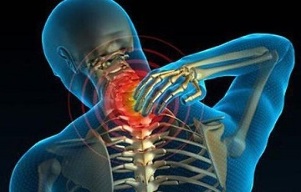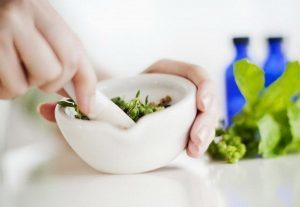
Cervical osteochondrosis is a progressive disease that is characterized by deformation and structural changes in the intervertebral disc.
Cervical osteochondrosis has become more common recently, which can be explained by the spread of a sedentary lifestyle (driving, sitting at the computer).
In contrast to the thoracic and lumbar spine, cervical osteochondrosis is much more common, which is due to the anatomy of the cervical spine. The fact is that in the neck area, the vertebrae are close enough to each other and the muscle frame is poorly developed, which leads to a displacement of the vertebrae even with small loads on the cervical area and, as a result, compression of blood vessels and nerves.
Causes of cervical osteochondrosis
relationship - cervical osteochondrosis, dizziness, fears, tension and depression.
No less relevant cause of the manifestation and exacerbation of cervical and vertebral osteochondrosis is the mental factor of the person - these are frequent or constant loads, fears, fears, a state of depression, which is always accompanied by internal stresses that arise.
Our spine, including the neck section, consists of 24 vertebrae and intervertebral discs (cartilage). To keep this entire structure strong and strong, the spine is connected to many muscles and ligaments that form a type of corset. A very important role in this design is played by intervertebral discs, which allow the vertebrae to move relative to one another, thereby providing amortization.
If exactly these intervertebral discs or vertebrae are damaged (structural change due to metabolic disorders), osteochondrosis occurs, which is named after the affected area: cervical osteochondrosis, thoracic and lumbar spine.
In cervical osteochondrosis, the nerve roots emanating from the spinal cord are pinched and the vessels are compressed, which disrupts blood flow. because blood is difficult to move in tense muscles. Of course, the blood supply to the brain is also disturbed, causing a lack of oxygen.
Also, all of these nerves that come from the spinal cord are connected to our internal organs, and therefore their work is also disrupted.
Cervical osteochondrosis can also be caused by:
- injuries to the intervertebral discs;
- weightlifting;
- wrong posture;
- hypothermia, draft;
- executed procedures incorrectly, e. g. B. Massage and others.
- overeating, overweight - excessive load on the spine;
- the use of spicy, salty aggravates osteochondrosis;
- congenital or acquired scoliosis, kyphosis, lordosis;
- longer exposure to vibration - working with construction machinery, driving a car, etc.
- uncomfortable bed, duvets, large pillows, so the position of the neck is wrong while sleeping;
- hereditary predisposition;
- not only puts a lot of strain on the spine, but also, for example, monotonously;
- pathology of the muscular ligament apparatus;
- asymmetry of the temporomandibular joint, its injuries, chewing habits, malocclusion;
- tight, uncomfortable bra straps, tight collars;
- work with strenuous movements of the same type (especially when bending forward): sawing, splitting firewood, gardening with a shovel, with a hoe, washing on the board, vacuuming and the like.
Symptoms of cervical osteochondrosis
Symptoms of cervicothoracic osteochondrosis are directly related to the target. In this regard, a group of syndromes is distinguished that accompany this disease:
- Radicular syndromes.Radicular syndrome occurs when the nerve roots in the cervical area are compressed (pinched nerve). It is also known as cervical radiculitis. The pain in the neck is transmitted downwards and can reach the shoulder blade and even the outer part of the forearm to the fingers. Among the symptoms of cervical osteochondrosis, in some cases, there is tingling of the forearm, hand or fingers, pies, and the effect of goose bumps.
- Stimulus reflex syndrome.In the case of reflex-reflex syndrome, symptoms of cervical osteochondrosis may be acute burning pain in the neck or back of the head that occurs when moving after a static state (with sharp turns of the head, when sneezing, after sleep). The pain can radiate to the shoulder and chest.
- heart syndrome.The symptoms of cervical osteochondrosis in this syndrome are largely consistent with the symptoms of angina pectoris. In this case, it is very important not to make a mistake in the diagnosis. In cardinal syndrome, the nature of the pain is paroxysmal and prolonged (up to several hours). Increased pain occurs with sudden movements caused by coughing, sneezing, and a sharp turn of the head. Often the appearance of tachycardia and extrasystole is observed against the background of the complete absence of signs of circulatory disorders.
- vertebral artery syndrome.In this case, cervical osteochondrosis is accompanied by a symptom such as a throbbing or burning headache, which most commonly affects the superciliary region, the back of the head, the temple and the darkness. As a rule, the pain practically does not stop, and only in some cases has a paroxysmal character. Increased pain occurs when moving or after prolonged stay in an uncomfortable position.
There is the possibility of hearing and visual impairment (reduced hearing and visual acuity, tinnitus, vestibular disorders, eye pain). Against the background of general weakness of the body, nausea or loss of consciousness is possible.
In summary, we can distinguish a number of symptoms that are most characteristic of osteochondrosis of the cervical spine:
- constant pain in the neck that spreads to the shoulder girdle, the area of the ears and eyes, the back of the head and does not stop even at night;
- Pain in hands, forearm, shoulder, which worsens even with low stress;
- Weakening of muscle strength and decreased sensitivity of hands, hands, fingers, as well as difficulties in their movements;
- pain in the neck when turning and tilting the head;
- Tension of the neck muscles, feeling of leaning back in the morning;
- Burning sensation, numbness, tingling in the legs or arms;
- extensive headache with primary localization in the back of the head;
- darkening of the eyes, tinnitus, numbness of the tongue, dizziness, with a sharp turn of the head - fainting,
- decreased visual acuity and hearing;
- proliferation of connective tissue in the cervical spine;
- pain in the heart area.
Medicines for cervical osteochondrosis
Cervical osteochondrosis is a complex disease that requires long-term, systematic and gradual treatment. Therapy is aimed at eliminating pain and fighting the inflammatory process in the affected area.
Patients are prescribed analgesics. Recently, nonsteroidal anti-inflammatory drugs that are effective in eliminating pain syndrome and helping to reduce the activity of the inflammatory process have become increasingly popular in the treatment of degenerative-dystrophic diseases of the spine.
In the treatment of cervical osteochondrosis, the appointment of chondroprotectors is indicated - drugs that slow down the destruction of cartilage tissue. Many doctors believe that the use of these drugs also promotes the regeneration of cartilage tissue.
The use of topical ointments and gels that contain irritants or nonsteroidal anti-inflammatory drugs is ineffective. The drug substance contained in it is unlikely to reach the affected area due to the barrier of the skin, subcutaneous tissue and muscles. Even so, it makes sense to use these external means, since when rubbing into the skin, a neck massage is performed.
To improve the regeneration and metabolic processes in the affected nerve root, vitamins of group B are prescribed to patients. Very often, doctors recommend that patients take combined vitamin preparations, which are administered intramuscularly.
Traditional methods of treating cervical osteochondrosis
Folk remedies definitely cannot be written off - cervical osteochondrosis, with its symptoms, can be treated at home with essential oils, herbs, fats, roots and poisons. They are combined with alcohols, iodine and turpentine and get very effective anti-inflammatory and warming agents for external and internal use.
Phytotherapy of cervical osteochondrosis
Celery means. Grate celery root on the finest grater, squeeze out the juice. Take celery juice for osteochondrosis, symptoms and treatment of the cervix three times a day for a tablespoon before meals at home.
Less concentrated version of the drug - for 1 tablespoon of juice, leave 100 ml of boiling water for a few hours, and an hour before meals, take a tablespoon of solution four times a day.
You can also use the root itself instead of juice - pour 3 grams of root 0. 5 liters of boiling water, let it sit for a couple of hours until it cools completely, then drink 20 ml before each meal.

Bay leaf remedy. Pour 12 grams of bay leaf with 300 ml of cold water into an enamel saucepan and cook for five minutes. Let it steep for three hours, then drain. Drink the infusion in small sips between meals throughout the day. Drink the rest before bed. Take the drug for four days, take a week off and repeat the course. Repeat the course every spring for prevention.
Herbal collection for cervical osteochondrosis. Grind and mix 100 grams of chamomile, parsley, hops and oregano, add 100 grams of nettle leaf and 200 grams of burdock root. Brew in a thermos and pour 1. 5 liters of boiling water. Leave on for three days. Drink the sieved solution in a tablespoon twice a day - morning and evening. Store in a cool, dark place.
Rubbing
Remedy for red pepper.Finely chop two hot red chili peppers, pour into a tightly sealed container and pour 200 ml of vegetable oil. Close tightly with a non-metallic lid. Let rest in a dark, warm place for five days. Rub into the affected area twice a day with gentle movements. There is no need to take a lot of money at once as it can burn a lot. The effect of the product heats up and blood circulation is improved.
Butter-based.Mix the egg with a tablespoon of vinegar, add a tablespoon of flour and 100 grams of softened butter. Leaving the product in a dark place for a few days, remove the film formed on the surface of the mixture and rub it into the skin in the area of cervical osteochondrosis during massage. Do not store the prepared mixture for more than 3 days.
Compressed
Burdock and horseradish leaves have proven themselves as compresses. They are scalded with boiling water, applied to the damaged area and wrapped in a cotton cloth for several hours. Repeat 10 times every day. Repeat 2-4 times a year.
Therapeutic exercises for cervical osteochondrosis
These exercises help both with existing osteochondrosis of the cervical spine and as a prophylaxis. In the evening, preventive gymnastics against cervical osteochondrosis can be carried out at home. However, it is better to take short breaks from work (this is a recommendation for people with sedentary work). Gymnastics for cervical osteochondrosis does not take much time, but it quickly gives a positive result.
- Exercise 1.Sit up straight, tilt your head back and try to reach your right shoulder with your right ear, then come back to the starting position. The exercise is carried out slowly and smoothly, the muscles are not tensed. Do five repetitions for each side.
- Exercise 2.Sit up straight, face forward, chin slightly raised. Slowly and gently turn your head to the right - as far as possible. Return to the starting position and immediately turn left. Repeat 5 times in each direction.
- Exercise 3.Place your palm on your forehead and press your head on it, while the palm should stay in the same place, i. e. should resist the pressure. While pressing with the head, you need to strain the neck muscles. Slowly count to 5 to yourself and relax. Repeat 3 times.
- Exercise 4.Exercise is similar to Exercise 3, only the palm (or two palms) should be placed on the back of the head and with them you press down on the palm. The tension must be maintained and count to 5. Repeat this three times.
- Exercise 5.Exercise is similar to Exercise 3, but in this case, place your right palm on your right temple and press your head against the palm. The tension must be maintained and count to 5. Repeat this three times. Do the same, placing your left palm on your left temple - repeat three times.
- Exercise 6.Sit up straight, tilt your head back slightly and then slowly and under tension, as if overcoming the resistance, lower your head and pushYour chin against your chest. Repeat 5 times.
- Exercise 7.Sit straight, lower your head and slowly turn your head to the right and left - 5 times in each direction. In this case, the head remains lowered.
Exercise for cervical osteochondrosis should not involve turning the head without hand support, especially at times when the neck is tense and painful.
Self-massage for cervical osteochondrosis

Self-massage never hurts, it is a key treatment at home. The main requirement is a frugal regime. You can not use excessive force, the process is carried out solely with your fingers. You can do this all day at least. It is advisable not to bend or tilt your neck while exercising.
It is necessary to start from the upper cervical vertebra and gradually lower the massaged area. The movements should be smooth spiral or circular from the center to the periphery top to bottom. If a muscle is stiff in the cervical area, it can be kneaded separately. Think about the symmetrical load. The time to massage the right and left parts is approximately the same. It will not be possible to completely cure the disease by self-massage, but it is entirely possible to slow the disease down and speed up recovery.
Nutrition for cervical osteochondrosis
For osteochondrosis of the cervical spine, doctors advise eating in small portions at least five times a day. Eat cooked or steamed meals. Drink at least 1. 5 liters of water a day. Season salads with olive oil. Avoid cigarettes and alcoholic beverages.
Include the following products in the menu:
- lean meat: beef, rabbit, chicken;
- Vegetables and fruits: cucumbers, tomatoes, carrots, onions, peppers, beets, cabbage, broccoli, celery, eggplant, avocado, spinach, watercress;
- Dairy products: cheese, cottage cheese, milk;
- Seafood: fish, lobster, oysters, crabs;
- Dishes with gelatin: jelly, jellied meat, aspic made from fish;
- Nuts and seeds: almonds, hazelnuts, sunflower seeds;
- mushrooms, eggs, grain.
Try to eat less sugar, grapes and broths. Eliminate salty and smoked foods, flour products, and hot spices from the diet.
Prevention of cervical osteochondrosis
As usual, proper prophylaxis will help prevent osteochondrosis of the cervical spine. Of course, all physical exercises must be done regularly, otherwise "periodic" exercises are of little use.
There are simple rules to follow:
- exercise regularly, especially swimming, aqua aerobics, gymnastics for stretching, and the flexibility of the vertebrae is also good for preventing osteochondrosis, which can be practiced at home.
- Eat more foods high in calcium and magnesium. These are fish, peas, legumes, nuts, cheese, herbs, but it is better to do without sugar, flour, smoked, spicy;
- Choose a good orthopedic mattress and pillow that are ideal for the neck and keep the head in the correct anatomical position while you sleep (yes, your favorite huge down pillows won't go away with spinal problems! ).
- While seated, do a special series of medical gymnastics exercises at least a few times a day.







































